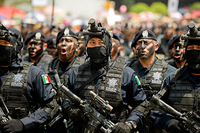-
Florida university distances itself from professor's claim that Sandy Hook shooting was staged by the government
A Florida university professor publicly questioned whether the Newtown, Connecticut shooting happened, or whether it was a government drill, forcing his employer, Boca Raton-based Florida Atlantic University, to distance itself from him; professor James Tracy also raised questions about whether the Aurora, Colorado movie theater shooting ever happened
-
-
Emergency management technology is customized for use in school security
School shootings are a very real fear for parents and school administrators, and a Ohio company has customized its emergency response solution for use in schools; the Web-based system which gives first responders eyes-on access to critical situational information, such as maps, floor plans, emergency protocols, call lists, and real-time video feeds where there are cameras
-
-
White House considering gun-control measures beyond assault weapons ban
Sources in the White House say the administration is considering a broader and strategy on guns control in the wake of the Newton, Connecticut, mass shooting; the approach being considered will go farther than a ban on certain types of assault weapons; the Biden task force, which will submit its recommendations to President Obama in a few weeks, is leaning toward adoption of measures recommended by the law enforcement community, among them requiring universal background checks for firearm buyers, tracking the movement and sale of weapons through a national database, strengthening mental health checks, and stiffening penalties for carrying guns near schools or giving them to minors
-
-
U.S.-born cleric Anwar al-Awlaki purchased tickets for 9/11 terrorists: FBI documents

Within two weeks of the 9/11 terrorist attacks, FBI investigators had information that New Mexico-born jihadi cleric Anwar al-Awlaki had purchased air travel tickets for some of the hijackers; the information is contained in newly released, and heavily redacted, FBI documents; it appears that after the 9/11 attacks, the FBI, rather than arrest al-Awlaki, tried to work with him or track him for intelligence purposes, to see whether he would lead the agency to sleeping-cell terrorists still in the United States; Al-Awlaki was killed by a CIA drone attack in Yemen in September 2011
-
-
Newspaper hires armed guards to watch editorial headquarters
A newspaper in Rockland County, New York offered its readers a map on its Web site which showed the names and addresses of all gun permit holders in Rockland and Westchester counties; worried about an angry reaction to the map, the newspaper hired private security guards to watch over its West Nyack headquarters
-
-
Gun training for teachers gaining in popularity
Two hundred teachers in Utah are set to receive special firearms training — with a plastic gun — in order to carry concealed weapons in their classrooms in the future; in the aftermath of the mass shooting in the Sandy Hook Elementary School in Connecticut, gun training and gun safety classes for teachers are drawing attention
-
-
Broader background checks, denial criteria may help prevent mass-shooting catastrophes
Garen Wintemute, a leading authority on gun violence prevention and an emergency medicine physician at the University of California, Davis, believes broader criteria for background checks and denials on gun purchases can help prevent future firearm violence, including mass shooting catastrophes such as those that occurred at Sandy Hook, Aurora, Virginia Tech, and Columbine
-
-
In Oklahoma, even rumors of threat of school violence are taken seriously, and investigated
Threats of violence in schools must be taken seriously, even if the threats are nothing more than rumors; in Tulsa, Oklahoma, police and school officials take every threat seriously, even if it is nothing more than gossip
-
-
Is stricter gun-control legislation more likely after Newtown shooting?
An American politics professor, specializing in the relationship between public opinion and legislation, says that the relationship between mass shooting and gun-control legislation is not straightforward;thus, there was a spike in support for gun control after Columbine, but not after the Virginia Tech, Tucson, or Aurora shootings; “The Newtown shooting is different than those shootings in some respects, especially because many of the victims were young children. But the magnitude of this tragedy may not be sufficient to produce stricter gun-control legislation at the federal level”
-
-
What we know, and what we can do, about school shootings
Since the early 1970s, school shootings at American elementary, secondary, and higher education institutions have been a painful reality for American society; after each incident — like the recent attack in Newtown, Connecticut — there is voluminous dialogue about what can be done to prevent the next such tragedy; a new study explores what we have learned about these tragic incidents, and what can be done to prevent them
-
-
New Mexican government to set up a new police force to fight drugs, crime

Mexican president Enrique Pena Nieto has said his government would create a new national police force as part of a new approach to dealing with drugs, crime, and violence; Pena Nieto took office on 1 December; the new, militarized police force would have about 10,000 officers initially, but would eventually grow to 40,000
-
-
Connection between goth subculture, mass shootings appears tenuous

Classmates of the otherwise bland and elusive Adam Lanza, who last Friday killed twenty children and six adults at the Sandy Hook school in Newton, Connecticut, described him as “goth”; is there a “goth” connection in the Newtown school shooting? The question is asked because news reports have connected several perpetrators of both mass shooting and killing on a smaller scale to goth culture; a closer examination shows that the relationship between goth and mass shooting is tenuous
-
-
NRA shuts down Facebook page in wake of Connecticut shooting
In the immediate aftermath of the Newtown shooting, the National Rifle Association (NRA) has deactivated its Facebook page, just one week after celebrating the fact that it has gathered 1.7 million “likes” on the page; the debate about whether the United States needs stricter gun controls continues, though
-
-
Breaking news: Gunman kills 27, self, in Connecticut elementary school
A 20-year old Newtown, Connecticut man entered the Sandy Hook Elementary School in town and began shooting; police says that, so far, there are twenty-seven dead and scores of injured; among the dead are twenty students and six staff members; most of the students were killed in the classroom of the gunman’s mother, who was also shot and killed; police reports that so far it appears that there is only one person injured who requires hospitalization
-
-
L.A. sued for detaining foreign nationals on “immigration holds”
The American Civil Liberties Union (ACLU) filed a class-action lawsuit against the Los Angeles County Sheriff’s Department (LASD) accusing it of illegally detaining people for days, weeks, or months after they should have been released. The reason for the continued detention is that those detained are subject to what is called “immigration hold”
-
More headlines
The long view
How Male Grievance Fuels Radicalization and Extremist Violence
Social extremism is evolving in reach and form. While traditional racial supremacy ideologies remain, contemporary movements are now often fueled by something more personal and emotionally resonant: male grievance.
